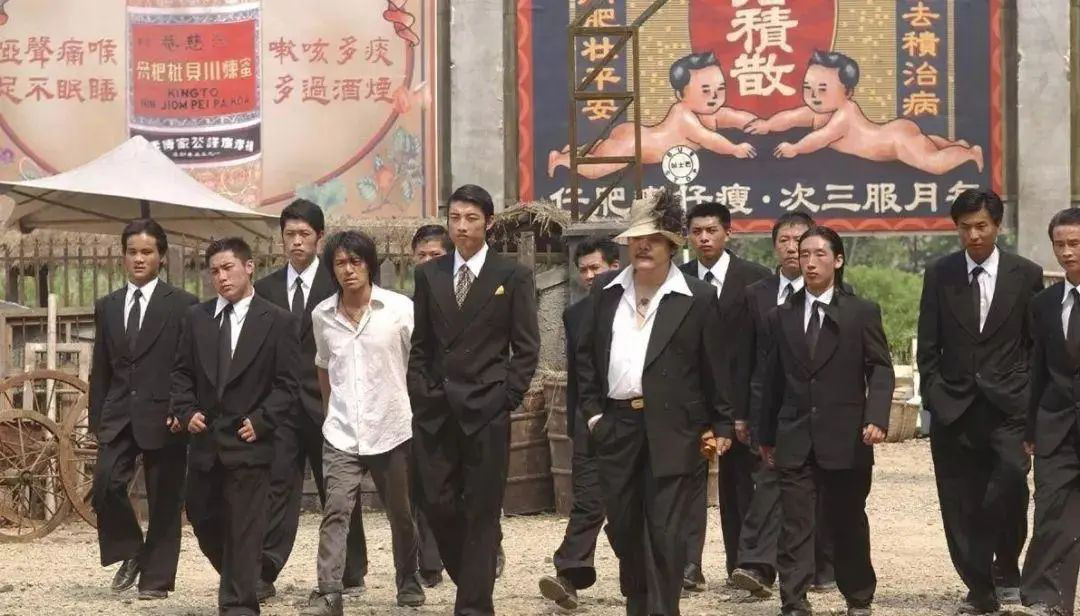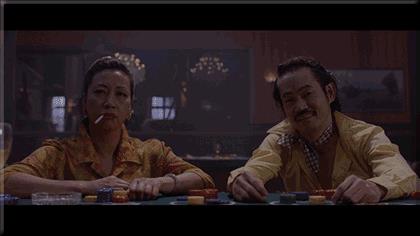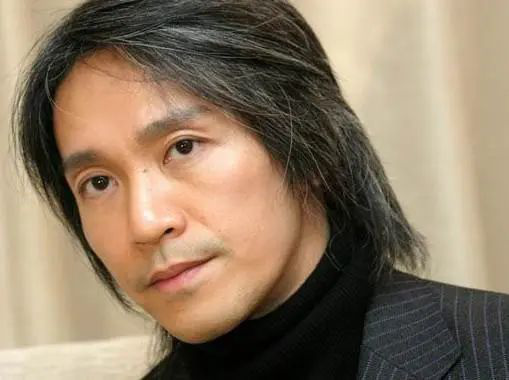The work of Zhou Xingchi!

During the "golden age" of Hong Kong cinema in the mid-1970s and early 1990s, more than a dozen film crews started work at the same time every day in this small city on the southern coast of China. Pretty boys and beautiful women from Hong Kong’s wireless artist training class came together and set up scenes among the various crews. Film and television companies such as Golden Harvest, Shaw’s and New Art City invested heavily in digging up and cultivating newcomers to compete in the entertainment industry. This also contributed to the miracle that Hong Kong films produced more than 200 films a year in the 1980s.


That golden age of Hong Kong cinema gave birth to countless movie superstars. They may be as good-looking as Chow Yun-fat, Andy Lau, and Tony Leung Chaowei, and their acting skills are first-class, becoming hot A-list actors. Or as daring as Samuel Hung, Jackie Chan, Yuan Biao, and Yuan Hua, who sacrificed their lives to complete eye-catching stunts and become action superstars.

However, those who can write, direct, and act, and are unique in artistic expression, can create a personal style, and even find a way to break out of a school of film, I think Xingye is one of the best.

The nonsensical style of "Zhou’s comedy" he pioneered and his special attention to the subject matter of the little people are enough to secure him the top spot in Chinese comedy, and it is no exaggeration to call it "Asian Jim Carrey".

Today, let’s talk about the most outstanding work of Xing Ye in the 21st century so far – "Kung Fu"


First, the self-cultivation of "little people"
The story of "Kung Fu" still follows the tradition of Xing Ye’s "little person narrative", telling the story of the 1940s Shanghai, when A Xing, a street gangster who has been bullied since childhood, tried to get ahead by pretending to be the "Axe Gang" and extorting in the "Pig Cage City". As a result, he attracted the real "Axe Gang" forces.

The unexpected invasion of the gangster forces disturbed the quiet life in the slum, and also disturbed the four peerless kung fu masters who were entrenched here – the inheritors of the Gorang Bagua Band, the Hong Family’s Iron Wire Fist and the Shaolin 12th Road Tan Leg.

The gangsters were naturally no match for the descendants of the divine arts, but the arrogant Axe Gang boss, Brother Kun, was unwilling to stop, so he used the gang’s power to invite peerless experts to try to level the "Pig Cage City" in one fell swoop. Every attack by Brother Kun would stir up more "masters" hidden in the secular world in this unsightly small pool. Until, Brother Kun used his head to sacrifice the ultimate killing king Huoyun Evil God, and his opponent was the little rascal A Xing who caused this disturbance.

Lord Xing wrote, directed and acted himself, focusing the guide tube on the little character A Xing, making him a witness and key participant in the contest between the "evil forces" and the "pig cage city". Every turn in the battle between the two sides was caused by A Xing’s inadvertent speculation.

The first time was when he saw that he was going to be beaten by the residents of the city, so he had to learn the way the Axe Gang used fireworks to call people and threw a cannon fight. As a result, it just blew up the head of the leader of the Axe Gang passing by the wall. Then the villain complained first and blamed the residents of the city, which caused a conflict between the two forces.

The second turning point was that Ah Xing, with an incomparable desire to get ahead, put down all his courtesy and shame to join the Axe Gang. As a result, the first task he received was to rescue the great devil Fire Cloud Evil God from the mental hospital.
Xing clearly knew that his actions were wrong, but he seemed to have been carried away by the desire to become famous. As a result, with the release of the Fire Cloud Evil God, an uncontrolled force of destruction swept through the entire Axe Gang and the city.

The third turning point was when the charterer and the charterer in the base camp of the Axe Gang faced off against the three masters who were entangled with each other, and A Xing chose to use a wooden stick to beat the Fire Cloud Evil God.

This time, the little gangster Ah Xing finally stood on the side of justice. But this also caused the evil god of fire clouds to go berserk directly, breaking Ah Xing’s meridians with a fist, and his life was hanging by a thread. It was precisely because of his walk through the gate of hell that Ah Xing’s potential as a "martial arts genius" was completely exploded.

It can be said that in the first half of the film, Ah Xing has always been a gangster who makes a living by picking locks and speculating. For fame and fortune, he can join gangs, bully civilians, and even rob a girl who buys candy.

But in the end, he was just a small person, without noble virtue or the ferocity of a big traitor, between good and evil. He did not dare to kill, set fire, or rape. After being bitten by a snake, he had to hide in the traffic light box and silently digest the pain.

But it was after a series of setbacks and tribulations that Ah Xing finally realized how precious the opportunity to "be a good person" was, and how despicable it was to be self-deprecating on the old road of a gangster. Therefore, the moment he completed the good and evil decision, the potential hidden in his body also fully exploded.


Eight kung fu stunts, combining Chinese martial arts
Since the movie is called "Kung Fu", the core element of the story is naturally Chinese martial arts. In the "imagined China" in Jin Yong and Gu Long’s martial arts novels, Chinese martial arts can be said to have a long history and many branches. The kung fu of Shaolin, Wudang, Emei, Beggar Gang, and Tai Chi schools have their own strengths and weaknesses, and together they have painted the world of pleasure, enmity, swords, light and shadows.
On the one hand, Xing Ye’s "Kung Fu" continues the tradition of Hong Kong martial arts novels, and on the other hand, it inherits the mantle of Hong Kong martial arts films and kung fu films. The eight kung fu that appear in it can be said to be both a reinterpretation of traditional Chinese kung fu and a tribute to Hong Kong classic kung fu films. Let’s take a look at it together:
(1) The Tathagata Palm
The most invincible kung fu in the film "Tathagata’s Palm" is actually a fiction invented by Hong Kong filmmakers. It first appeared in the Hong Kong film "Tathagata’s Palm" in the last century, and was portrayed as the Buddha created for all living beings. There are ten styles.

At the end of the film, Ah Xing used the ninth form of "Ten Thousand Buddha Dynasty". Later, it was continuously interpreted by people, and the Tathagata Divine Palm became a kind of divine power that interacted with the "Heavenly Remnant Foot".

(2) Toad Gong
"Toad Technique" was a must-kill skill of the Fire Cloud Evil God. He once used this skill to put Ah Xing at a disadvantage.
The toad skill comes from Jin Yong’s martial arts novel. It is the original stunt of Western Poison Ouyang Feng, and later passed on to his righteous son Yang Guo.

Its characteristic is that it is like a toad preying on insects, waiting for an opportunity to move, using static braking, and striking after. When the enemy attacks, it pounces suddenly, concentrating all its internal force on one point and bursting out, killing it in one blow.
(3) (4) Shaolin Nanquan North Leg – "Hongquan" and "Tan Leg"

The tailors and laborers who live in seclusion in the Kowloon walled city in the film are the descendants of Hong Quan and Tan Ju respectively. Hong Quan was pioneered by Hong Xiguan, a Cantonese from the Qing Dynasty. When he was a teenager, he studied under the Shaolin sect and integrated the kung fu of the North and South Shaolin with his extremely high understanding. He created a school of "Hong Quan" that combines internal and external cultivation, uses both fists and feet, and combines strength and softness.
The person who plays the tailor in the film is Zhao Zhiling, the apprentice of Huang Feihong, and the iron wire boxing he practices is also one of the five battles of Hongquan.

There are many theories about the origin of "Tan leg", including Shaolin Temple in Songshan, Henan, Longtan Temple in Shandong, and many other theories. Later, the Jingwu Association of Huo Yuanjia in Tianjin also taught this kind of kung fu. There is a proverb that goes "If you practice boxing without training your legs, you are like a daredevil". The Tan leg style, with sharp movements, changeable moves, and quick attack and defense, can complement the boxing technique well.
(5) Goro gossip stick
The origin of this stick technique is hidden in the name. The so-called "Goro" refers to Yang Goro, who fought against the Khitan people in the Southern Song Dynasty. When he was defeated in the battle with his father at the Golden Beach, he disguised himself as a monk.

Later, he really went to Mount Wutai to cut his hair and become a monk, and changed the Yang family’s marksmanship to a stick technique, creating the "Gorang Bagua Stick". The actor who plays the boss Yang in the film is Dong Zhiping, a Peking Opera martial artist, whose gun and stick skills are first-class.
(6) Tai Chi
This can be said to be the most well-known kung fu in the film. In the film, the charterer plays "Chen’s Tai Chi" originating from Chenjiagou, Henan. With Taoist Tai Chi and Yin and Yang as the mental method, he pays attention to both internal and external cultivation, combining rigidity and softness, and overcoming rigidity with softness.

Although the chartered public can use a set of superb tai chi to play the six-fingered piano demon in the palm of his hand, he is a "rake ear" and has to swallow his anger and bear the humiliation in the face of his wife’s domestic violence.
(7) The Lion’s Roar

The renter’s Lion’s Roar skill, which is comparable to ultrasonic weapons in the film, is one of Shaolin’s seventy-two stunts. When the power is performed, the qi is first sank in the dantian, and then it spreads for thousands of miles, which can be transmitted for miles. Hearing it, the heart is frightened and the back is cold. As Du Fu said in his poem, "When I suddenly hear the roar of a lion in Hedong, I am at a loss when the cane falls on my hand." Presumably, only a strong and domineering renter can control it freely.
(8) Three-hole Qin Demon – Shaolin Dragon Claw Hand
In the film, the two of the three-hole piano demons stroke a guqin together, the sound of the piano turns into the light of the sword and the shadow of the sword, the lights turn off the grass wherever they go, and the killing is invisible. This kung fu can be regarded as the original of Xingye, which is composed of the six-style fingerings of the guzheng and the Shaolin dragon claws.

Of course, Xing Ye was also inspired by the "Fuqin Style" and "Drum Style" in Jin Yong’s novels, which Zhang Wuji once used in the Shaolin Dragon Gripper.

Three or ten years of preparation only to fulfill the "Kung Fu Dream"
In fact, Xing Ye had wanted to put "Kung Fu" on the stage as early as 2005. One of his original intentions when he set up his own color star company to film "Journey to the West" was to use the money he earned to shoot his dream work – "Kung Fu".

However, the nonsensical style of "Journey to the West" exceeded the upper limit of the audience’s understanding at that time, encountering an unprecedented box office waterloo, which directly led to the bankruptcy of the color star company and the plan to shoot "Kung Fu" was stranded indefinitely.

From "Journey to the West" in 2005 to "Kung Fu" in 2004, Xing Ye also filmed another classic work, "The King of Comedy" in 1999. It can be said that these three works, separated by five years from each other, together form the "Iron Triangle" of Zhou’s comedy across the centuries at a very high level.

Looking back now, in fact, the box office failure of "Journey to the West" at that time was not necessarily a bad thing. It was with the precipitation and tempering of the next ten years that Xingye was able to polish the script and works to such an exquisite level.

Moreover, based on the special effects level of the 1990s to shoot kung fu, the final scene of A Xing’s group fighting the Axe Gang and the Tathagata’s palm defeating the Fire Cloud Evil God would definitely be very simple, difficult to achieve the desired effect, and unable to perfectly interpret Xing Ye’s understanding of kung fu.